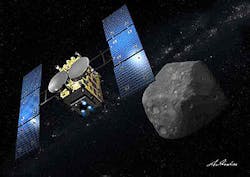Sofradir hyperspectral detector en route to asteroid on board the Hayabusa-2 space mission
A hyperspectral detector made by Sofradir (Palaiseau, France) is part of the Japanese Space Agency (JAXA) space mission Hayabusa-2, which was successfully launched on December 3, 2014 from Tanegashima space center by a Japanese rocket. In mid-2018, the Hayabusa-2 probe will reach the asteroid 1999 JU3, and will drop the Mascot lander on the asteroid surface for in-situ analysis. The mission will end in 2020 with samples from the asteroid being returned to Earth.
Sofradir’s Neptune detector is part of the MicrOmega IR microscope developed by the Institut d'Astrophysique Spatiale (IAS; Orsay, France) with the support of the Centre National d'Études Spatiales (CNES; the French space agency). The Neptune detector, which has a 30-μm-pitch, 500x256-pixel mercury cadmium telluride (HgCdTe, or MCT) array sensitive from short-wave IR (SWIR) to low mid-wave IR (MWIR), will image the asteroid's surface using 365 spectral bandwidths between 0.95 μm and 3.65 μm, allowing the determination of the asteroid's composition (mineral, organic, water). Sofradir developed the Neptune detector more than ten years ago for space-based and airborne hyperspectral and spectrometry applications.
“Sofradir is extremely proud to be part of this new deep-space science mission that will surely excite every citizen and not only scientific teams, as we have lately witnessed with the ongoing Rosetta mission,” says Philippe Bensussan, Sofradir's chairman and CEO.
Sofradir has delivered approximately 70 space-proven second-generation IR-detector flight models worldwide over the last ten years, Along with its MCT technology, the company has added indium antimonide (InSb), indium gallium arsenide (InGaAs), and quantum-well infrared photodetector (QWIP) technologies as well.
Source: Sofradir

John Wallace | Senior Technical Editor (1998-2022)
John Wallace was with Laser Focus World for nearly 25 years, retiring in late June 2022. He obtained a bachelor's degree in mechanical engineering and physics at Rutgers University and a master's in optical engineering at the University of Rochester. Before becoming an editor, John worked as an engineer at RCA, Exxon, Eastman Kodak, and GCA Corporation.
